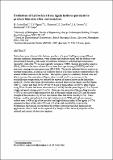Por favor, use este identificador para citar o enlazar a este item:
http://hdl.handle.net/10261/184864COMPARTIR / EXPORTAR:
 SHARE SHARE
 CORE
BASE CORE
BASE
|
|
| Visualizar otros formatos: MARC | Dublin Core | RDF | ORE | MODS | METS | DIDL | DATACITE | |

| Título: | Evaluation of hydrochars from lignin hydrous pyrolysis to produce biocokes after carbonization |
Autor: | Castro-Díaz, M.; Uguna, C.N.; Florentino Madiedo, Laura CSIC ORCID ; Díaz-Faes González, Elvira CSIC ORCID ; Stevens, L.A.; Barriocanal Rueda, Carmen CSIC ORCID ; Snape, C.E. | Palabras clave: | Lignin Torrefaction Hydrous pyrolysis Biocoke Carbonization |
Fecha de publicación: | 19-nov-2016 | Editor: | Elsevier | Citación: | Journal of Analytical and Applied Pyrolysis 124: 742-751 (2017) | Resumen: | Hydrochars were obtained after hydrous pyrolysis of a pine Kraft lignin using different reaction conditions (temperature, water content and residence time) and the residues were characterized through a wide range of analytical techniques including high-temperature rheometry, solid-state 13C nuclear magnetic resonance (NMR), thermal gravimetric analysis (TGA), diffuse reflectance infrared Fourier transform spectroscopy (DRIFTS) and field emission scanning electron microscopy (FE-SEM). The results indicated that an increase in reaction temperature, an increase in residence time or a decrease in water content reduces the amount of fluid material in the residue. The hydrous pyrolysis conditions studied were not able to increase the maturation of lignin, which would result in an increase in the resolidification temperature, but reduced the amount of mineral matter in the hydrochar produced. On the other hand, the hydrochars obtained from pristine lignin, torrefied lignin (300 °C, 1 h) and their 50:50 wt.%/wt.% blend at temperatures of 350 °C after 6 h using 30 ml of water had lower ash contents (<2 wt.%) than the parent lignin (2.5 wt.%) and a high rank good coking coal (10 wt.%). However, the reactivity of the resulting biocokes (>45%) is excessively high compared to that of the good coking coal (10%) and the micro-strength of the biocokes (R1<1%) is much lower than that of the coal (R1 = 17%). These findings could be rationalized by the high total porosity (>39%) and high microporous surface areas ( > 400 m2/g) of the biocokes and high alkalinity index of the lignins (>27%) compared to those of the coke (27% and 145 m2/g) and coal (0.6%), respectively. Furthermore, the biocoke derived from the hydrous pyrolysed torrefied lignin did not agglomerate, which could not be explained by changes in the chemical properties of the material and requires further investigation. | Versión del editor: | https://doi.org/10.1016/j.jaap.2016.11.010 | URI: | http://hdl.handle.net/10261/184864 | DOI: | 10.1016/j.jaap.2016.11.010 | ISSN: | 0165-2370 | E-ISSN: | 1873-250X |
| Aparece en las colecciones: | (INCAR) Artículos |
Ficheros en este ítem:
| Fichero | Descripción | Tamaño | Formato | |
|---|---|---|---|---|
| JAAP_Evaluation_Hydrochars_Castro.pdf | 1,82 MB | Adobe PDF |  Visualizar/Abrir |
CORE Recommender
SCOPUSTM
Citations
24
checked on 21-abr-2024
WEB OF SCIENCETM
Citations
20
checked on 29-feb-2024
Page view(s)
242
checked on 24-abr-2024
Download(s)
189
checked on 24-abr-2024
Google ScholarTM
Check
Altmetric
Altmetric
Este item está licenciado bajo una Licencia Creative Commons

